A Report on Job Satisfaction Among Workers in Public Service
VerifiedAdded on 2021/06/15
|16
|3764
|23
Report
AI Summary
This report investigates job satisfaction among workers in public service, with a specific focus on the Australian Taxation Office. The study aims to establish the relationship between job satisfaction and employee performance, exploring factors that contribute to employee contentment and engagement. The report includes a literature review discussing existing research and theories on job satisfaction, such as Locke's definition and Maslow's hierarchy of needs. The methodology section outlines the use of a case study design with qualitative data collection through interviews and questionnaires, followed by thematic analysis. The research examines the influence of intrinsic and extrinsic attributes on satisfaction, addressing research hypotheses about the impact of job satisfaction on employee engagement and performance. The report also considers the limitations, delimitations, and validity/reliability of the study, offering insights into the complex dynamics of job satisfaction within a public service context.
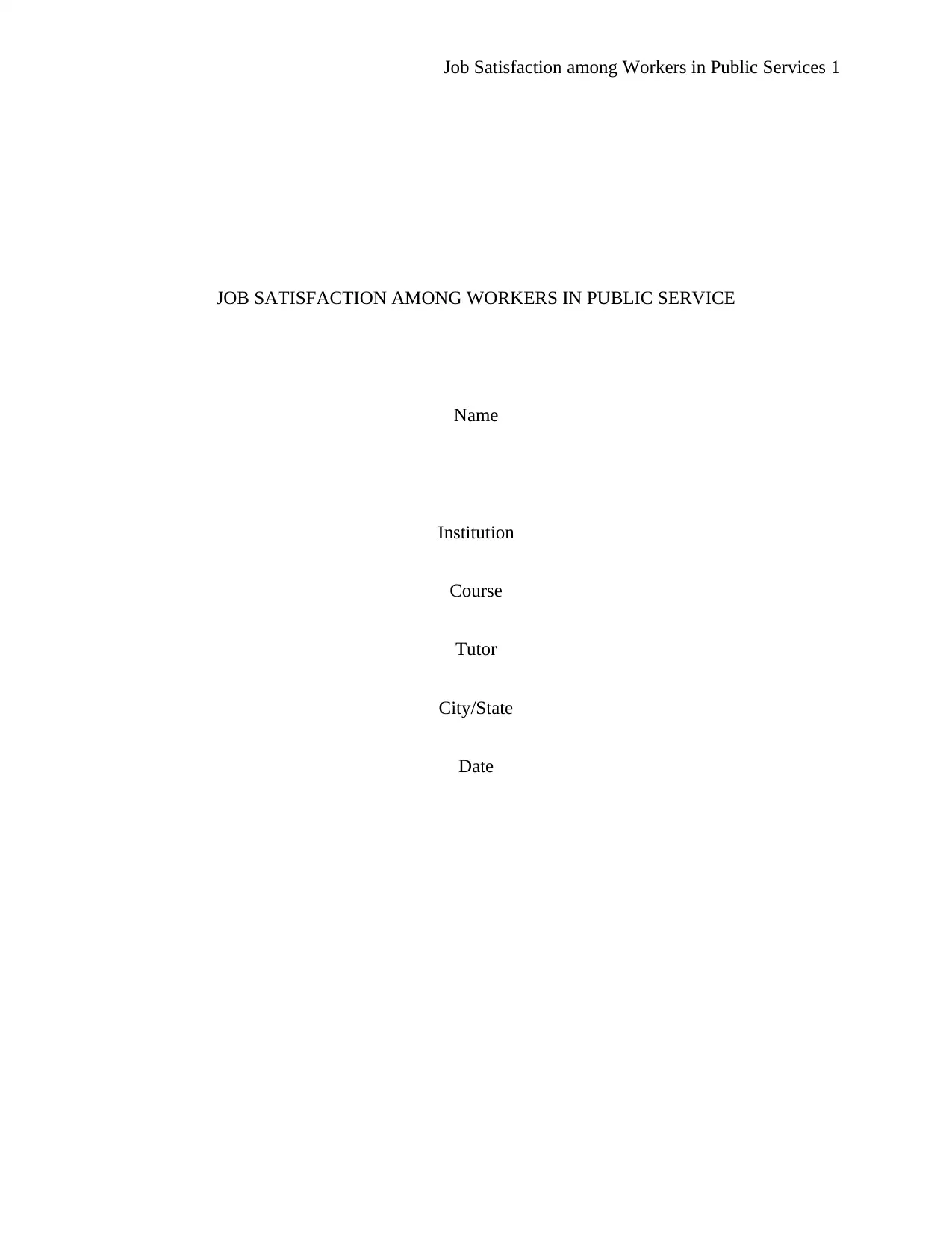
Job Satisfaction among Workers in Public Services 1
JOB SATISFACTION AMONG WORKERS IN PUBLIC SERVICE
Name
Institution
Course
Tutor
City/State
Date
JOB SATISFACTION AMONG WORKERS IN PUBLIC SERVICE
Name
Institution
Course
Tutor
City/State
Date
Paraphrase This Document
Need a fresh take? Get an instant paraphrase of this document with our AI Paraphraser
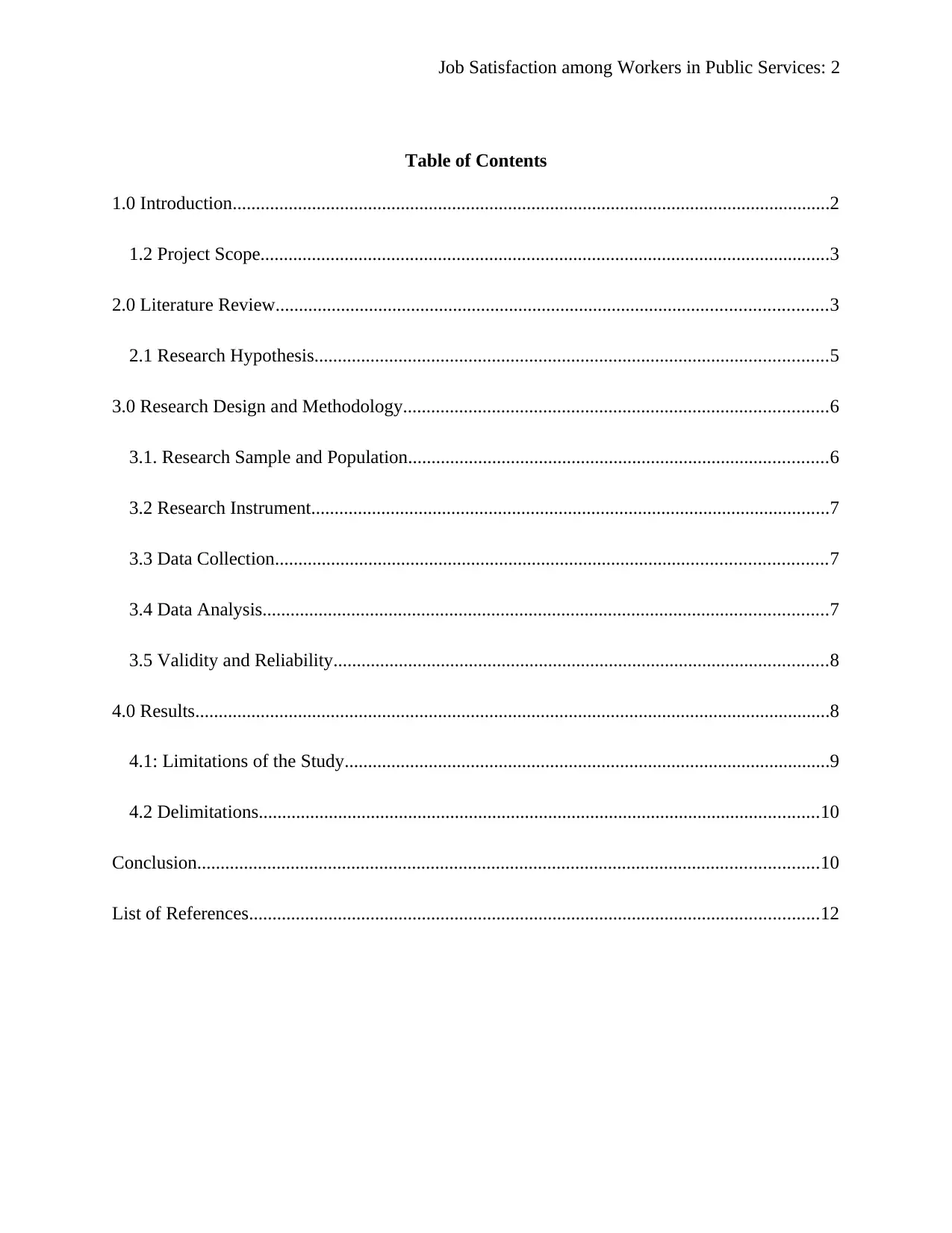
Job Satisfaction among Workers in Public Services: 2
Table of Contents
1.0 Introduction................................................................................................................................2
1.2 Project Scope..........................................................................................................................3
2.0 Literature Review......................................................................................................................3
2.1 Research Hypothesis..............................................................................................................5
3.0 Research Design and Methodology...........................................................................................6
3.1. Research Sample and Population..........................................................................................6
3.2 Research Instrument...............................................................................................................7
3.3 Data Collection......................................................................................................................7
3.4 Data Analysis.........................................................................................................................7
3.5 Validity and Reliability..........................................................................................................8
4.0 Results........................................................................................................................................8
4.1: Limitations of the Study........................................................................................................9
4.2 Delimitations........................................................................................................................10
Conclusion.....................................................................................................................................10
List of References..........................................................................................................................12
Table of Contents
1.0 Introduction................................................................................................................................2
1.2 Project Scope..........................................................................................................................3
2.0 Literature Review......................................................................................................................3
2.1 Research Hypothesis..............................................................................................................5
3.0 Research Design and Methodology...........................................................................................6
3.1. Research Sample and Population..........................................................................................6
3.2 Research Instrument...............................................................................................................7
3.3 Data Collection......................................................................................................................7
3.4 Data Analysis.........................................................................................................................7
3.5 Validity and Reliability..........................................................................................................8
4.0 Results........................................................................................................................................8
4.1: Limitations of the Study........................................................................................................9
4.2 Delimitations........................................................................................................................10
Conclusion.....................................................................................................................................10
List of References..........................................................................................................................12

Job Satisfaction among Workers in Public Services: 3
⊘ This is a preview!⊘
Do you want full access?
Subscribe today to unlock all pages.

Trusted by 1+ million students worldwide
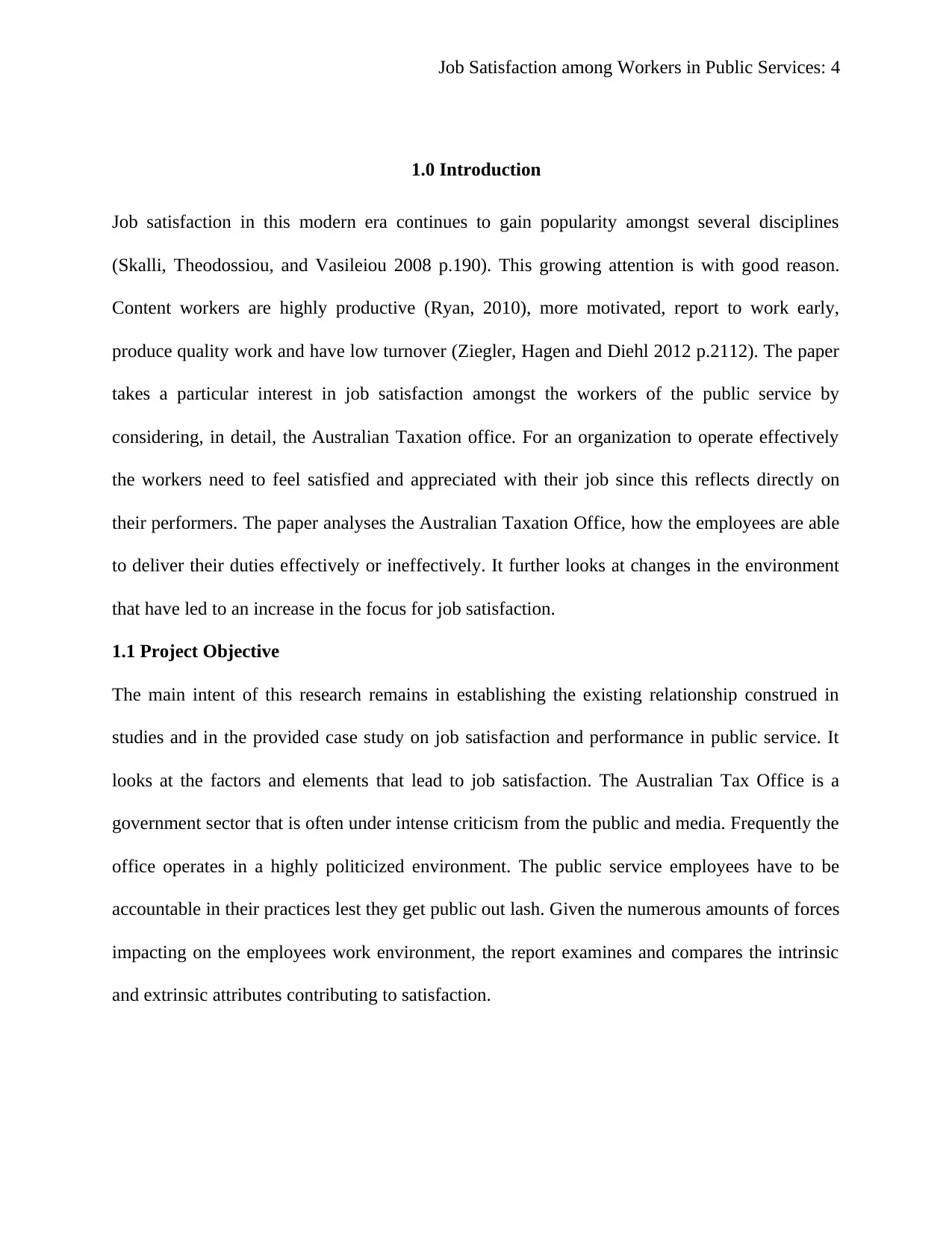
Job Satisfaction among Workers in Public Services: 4
1.0 Introduction
Job satisfaction in this modern era continues to gain popularity amongst several disciplines
(Skalli, Theodossiou, and Vasileiou 2008 p.190). This growing attention is with good reason.
Content workers are highly productive (Ryan, 2010), more motivated, report to work early,
produce quality work and have low turnover (Ziegler, Hagen and Diehl 2012 p.2112). The paper
takes a particular interest in job satisfaction amongst the workers of the public service by
considering, in detail, the Australian Taxation office. For an organization to operate effectively
the workers need to feel satisfied and appreciated with their job since this reflects directly on
their performers. The paper analyses the Australian Taxation Office, how the employees are able
to deliver their duties effectively or ineffectively. It further looks at changes in the environment
that have led to an increase in the focus for job satisfaction.
1.1 Project Objective
The main intent of this research remains in establishing the existing relationship construed in
studies and in the provided case study on job satisfaction and performance in public service. It
looks at the factors and elements that lead to job satisfaction. The Australian Tax Office is a
government sector that is often under intense criticism from the public and media. Frequently the
office operates in a highly politicized environment. The public service employees have to be
accountable in their practices lest they get public out lash. Given the numerous amounts of forces
impacting on the employees work environment, the report examines and compares the intrinsic
and extrinsic attributes contributing to satisfaction.
1.0 Introduction
Job satisfaction in this modern era continues to gain popularity amongst several disciplines
(Skalli, Theodossiou, and Vasileiou 2008 p.190). This growing attention is with good reason.
Content workers are highly productive (Ryan, 2010), more motivated, report to work early,
produce quality work and have low turnover (Ziegler, Hagen and Diehl 2012 p.2112). The paper
takes a particular interest in job satisfaction amongst the workers of the public service by
considering, in detail, the Australian Taxation office. For an organization to operate effectively
the workers need to feel satisfied and appreciated with their job since this reflects directly on
their performers. The paper analyses the Australian Taxation Office, how the employees are able
to deliver their duties effectively or ineffectively. It further looks at changes in the environment
that have led to an increase in the focus for job satisfaction.
1.1 Project Objective
The main intent of this research remains in establishing the existing relationship construed in
studies and in the provided case study on job satisfaction and performance in public service. It
looks at the factors and elements that lead to job satisfaction. The Australian Tax Office is a
government sector that is often under intense criticism from the public and media. Frequently the
office operates in a highly politicized environment. The public service employees have to be
accountable in their practices lest they get public out lash. Given the numerous amounts of forces
impacting on the employees work environment, the report examines and compares the intrinsic
and extrinsic attributes contributing to satisfaction.
Paraphrase This Document
Need a fresh take? Get an instant paraphrase of this document with our AI Paraphraser
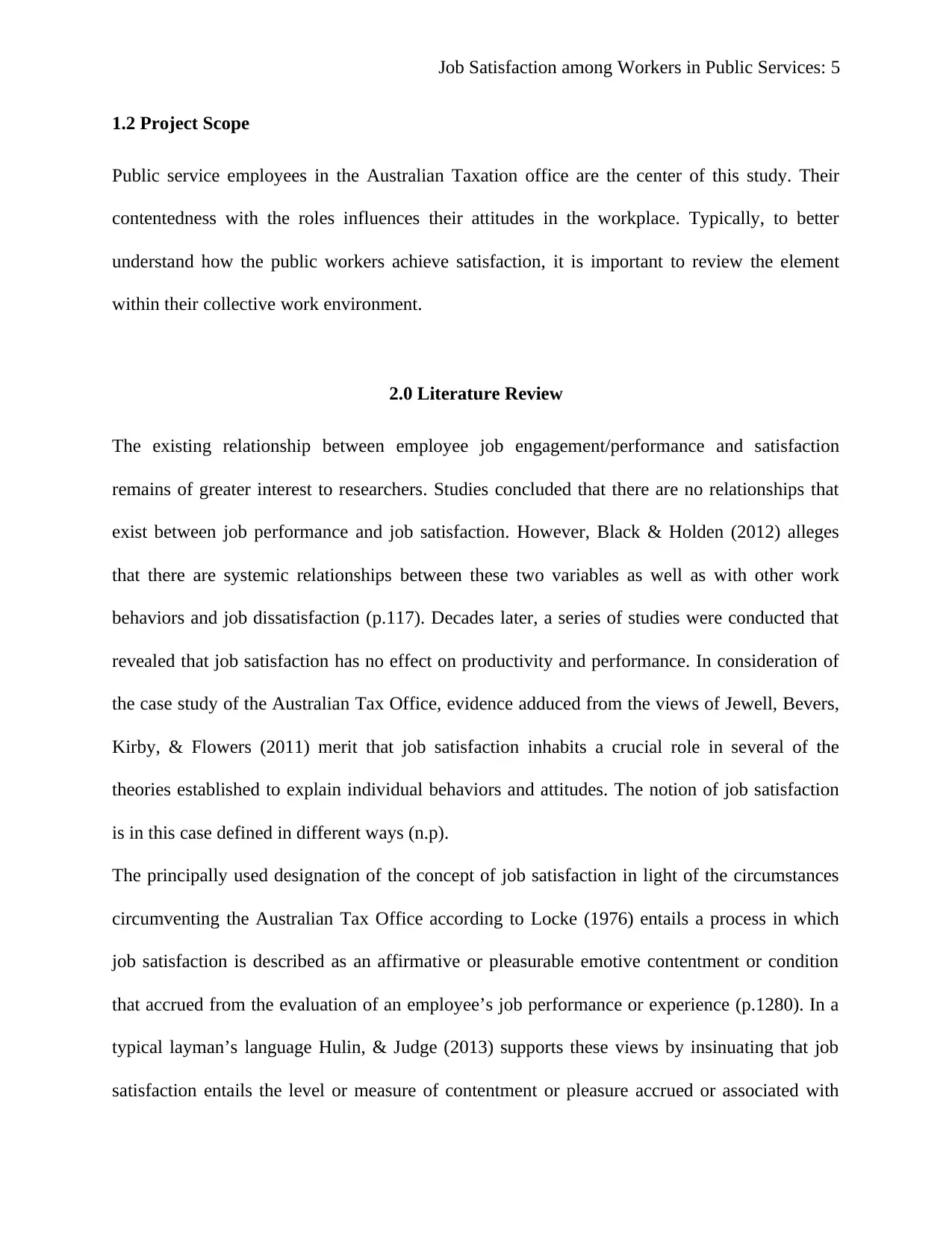
Job Satisfaction among Workers in Public Services: 5
1.2 Project Scope
Public service employees in the Australian Taxation office are the center of this study. Their
contentedness with the roles influences their attitudes in the workplace. Typically, to better
understand how the public workers achieve satisfaction, it is important to review the element
within their collective work environment.
2.0 Literature Review
The existing relationship between employee job engagement/performance and satisfaction
remains of greater interest to researchers. Studies concluded that there are no relationships that
exist between job performance and job satisfaction. However, Black & Holden (2012) alleges
that there are systemic relationships between these two variables as well as with other work
behaviors and job dissatisfaction (p.117). Decades later, a series of studies were conducted that
revealed that job satisfaction has no effect on productivity and performance. In consideration of
the case study of the Australian Tax Office, evidence adduced from the views of Jewell, Bevers,
Kirby, & Flowers (2011) merit that job satisfaction inhabits a crucial role in several of the
theories established to explain individual behaviors and attitudes. The notion of job satisfaction
is in this case defined in different ways (n.p).
The principally used designation of the concept of job satisfaction in light of the circumstances
circumventing the Australian Tax Office according to Locke (1976) entails a process in which
job satisfaction is described as an affirmative or pleasurable emotive contentment or condition
that accrued from the evaluation of an employee’s job performance or experience (p.1280). In a
typical layman’s language Hulin, & Judge (2013) supports these views by insinuating that job
satisfaction entails the level or measure of contentment or pleasure accrued or associated with
1.2 Project Scope
Public service employees in the Australian Taxation office are the center of this study. Their
contentedness with the roles influences their attitudes in the workplace. Typically, to better
understand how the public workers achieve satisfaction, it is important to review the element
within their collective work environment.
2.0 Literature Review
The existing relationship between employee job engagement/performance and satisfaction
remains of greater interest to researchers. Studies concluded that there are no relationships that
exist between job performance and job satisfaction. However, Black & Holden (2012) alleges
that there are systemic relationships between these two variables as well as with other work
behaviors and job dissatisfaction (p.117). Decades later, a series of studies were conducted that
revealed that job satisfaction has no effect on productivity and performance. In consideration of
the case study of the Australian Tax Office, evidence adduced from the views of Jewell, Bevers,
Kirby, & Flowers (2011) merit that job satisfaction inhabits a crucial role in several of the
theories established to explain individual behaviors and attitudes. The notion of job satisfaction
is in this case defined in different ways (n.p).
The principally used designation of the concept of job satisfaction in light of the circumstances
circumventing the Australian Tax Office according to Locke (1976) entails a process in which
job satisfaction is described as an affirmative or pleasurable emotive contentment or condition
that accrued from the evaluation of an employee’s job performance or experience (p.1280). In a
typical layman’s language Hulin, & Judge (2013) supports these views by insinuating that job
satisfaction entails the level or measure of contentment or pleasure accrued or associated with
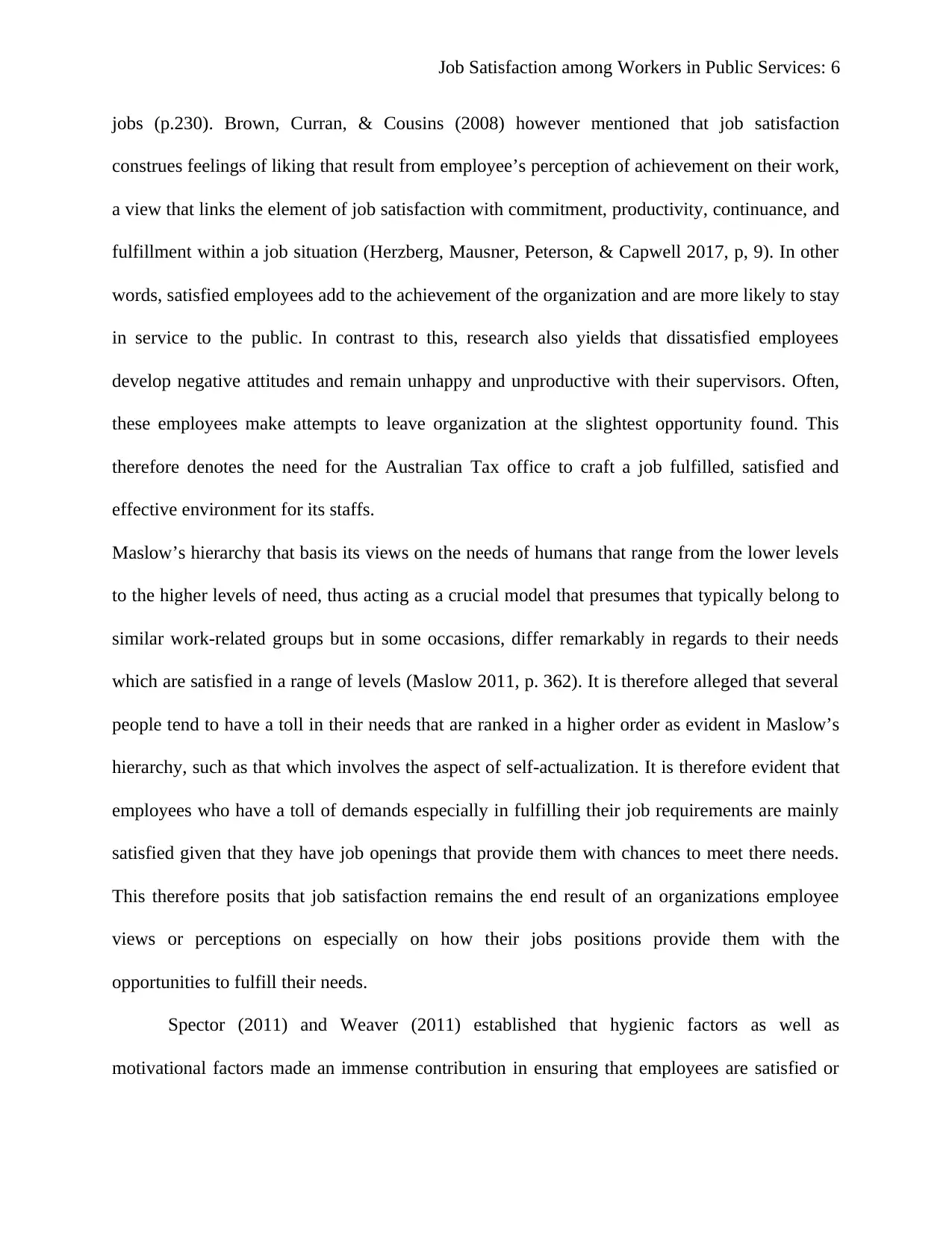
Job Satisfaction among Workers in Public Services: 6
jobs (p.230). Brown, Curran, & Cousins (2008) however mentioned that job satisfaction
construes feelings of liking that result from employee’s perception of achievement on their work,
a view that links the element of job satisfaction with commitment, productivity, continuance, and
fulfillment within a job situation (Herzberg, Mausner, Peterson, & Capwell 2017, p, 9). In other
words, satisfied employees add to the achievement of the organization and are more likely to stay
in service to the public. In contrast to this, research also yields that dissatisfied employees
develop negative attitudes and remain unhappy and unproductive with their supervisors. Often,
these employees make attempts to leave organization at the slightest opportunity found. This
therefore denotes the need for the Australian Tax office to craft a job fulfilled, satisfied and
effective environment for its staffs.
Maslow’s hierarchy that basis its views on the needs of humans that range from the lower levels
to the higher levels of need, thus acting as a crucial model that presumes that typically belong to
similar work-related groups but in some occasions, differ remarkably in regards to their needs
which are satisfied in a range of levels (Maslow 2011, p. 362). It is therefore alleged that several
people tend to have a toll in their needs that are ranked in a higher order as evident in Maslow’s
hierarchy, such as that which involves the aspect of self-actualization. It is therefore evident that
employees who have a toll of demands especially in fulfilling their job requirements are mainly
satisfied given that they have job openings that provide them with chances to meet there needs.
This therefore posits that job satisfaction remains the end result of an organizations employee
views or perceptions on especially on how their jobs positions provide them with the
opportunities to fulfill their needs.
Spector (2011) and Weaver (2011) established that hygienic factors as well as
motivational factors made an immense contribution in ensuring that employees are satisfied or
jobs (p.230). Brown, Curran, & Cousins (2008) however mentioned that job satisfaction
construes feelings of liking that result from employee’s perception of achievement on their work,
a view that links the element of job satisfaction with commitment, productivity, continuance, and
fulfillment within a job situation (Herzberg, Mausner, Peterson, & Capwell 2017, p, 9). In other
words, satisfied employees add to the achievement of the organization and are more likely to stay
in service to the public. In contrast to this, research also yields that dissatisfied employees
develop negative attitudes and remain unhappy and unproductive with their supervisors. Often,
these employees make attempts to leave organization at the slightest opportunity found. This
therefore denotes the need for the Australian Tax office to craft a job fulfilled, satisfied and
effective environment for its staffs.
Maslow’s hierarchy that basis its views on the needs of humans that range from the lower levels
to the higher levels of need, thus acting as a crucial model that presumes that typically belong to
similar work-related groups but in some occasions, differ remarkably in regards to their needs
which are satisfied in a range of levels (Maslow 2011, p. 362). It is therefore alleged that several
people tend to have a toll in their needs that are ranked in a higher order as evident in Maslow’s
hierarchy, such as that which involves the aspect of self-actualization. It is therefore evident that
employees who have a toll of demands especially in fulfilling their job requirements are mainly
satisfied given that they have job openings that provide them with chances to meet there needs.
This therefore posits that job satisfaction remains the end result of an organizations employee
views or perceptions on especially on how their jobs positions provide them with the
opportunities to fulfill their needs.
Spector (2011) and Weaver (2011) established that hygienic factors as well as
motivational factors made an immense contribution in ensuring that employees are satisfied or
⊘ This is a preview!⊘
Do you want full access?
Subscribe today to unlock all pages.

Trusted by 1+ million students worldwide
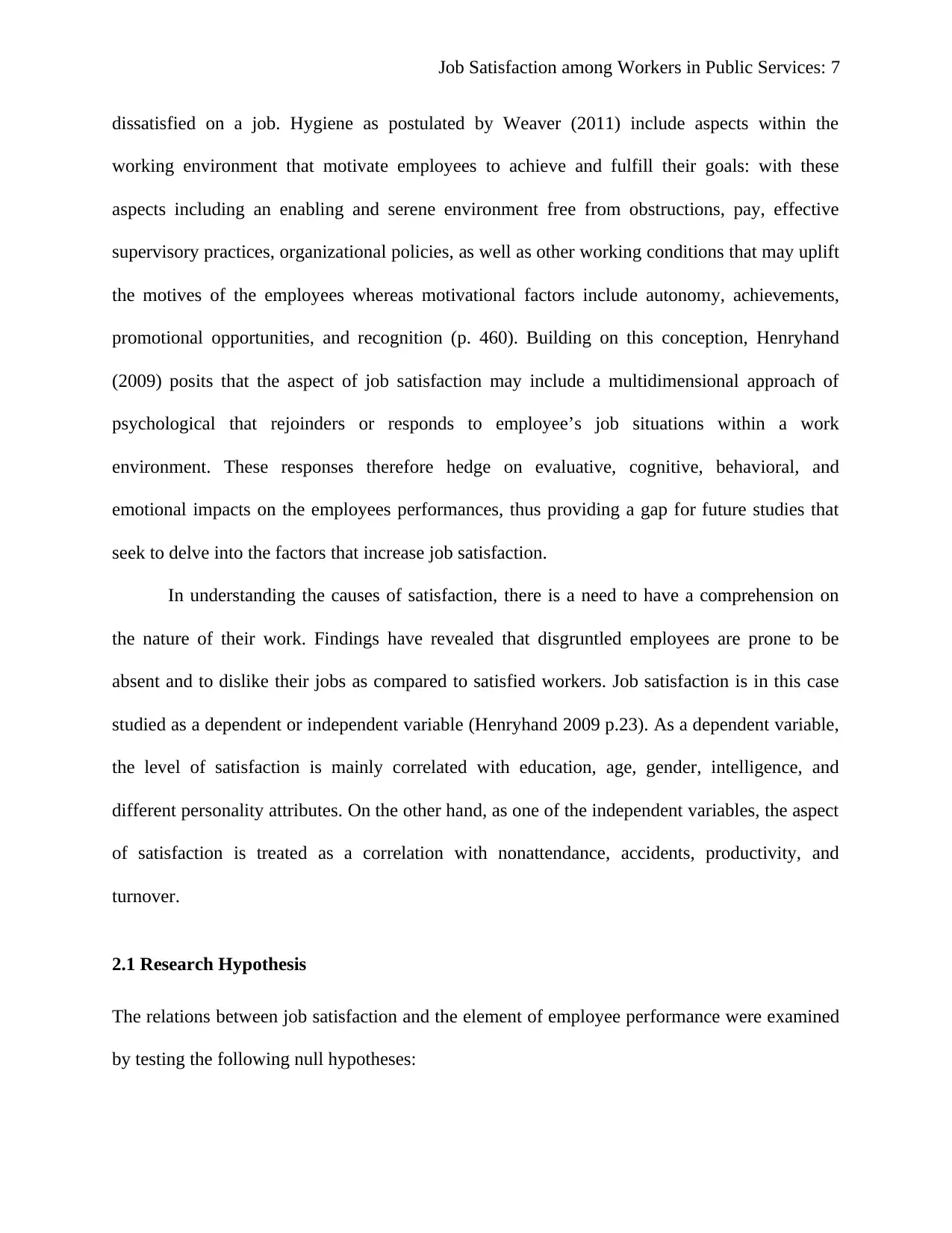
Job Satisfaction among Workers in Public Services: 7
dissatisfied on a job. Hygiene as postulated by Weaver (2011) include aspects within the
working environment that motivate employees to achieve and fulfill their goals: with these
aspects including an enabling and serene environment free from obstructions, pay, effective
supervisory practices, organizational policies, as well as other working conditions that may uplift
the motives of the employees whereas motivational factors include autonomy, achievements,
promotional opportunities, and recognition (p. 460). Building on this conception, Henryhand
(2009) posits that the aspect of job satisfaction may include a multidimensional approach of
psychological that rejoinders or responds to employee’s job situations within a work
environment. These responses therefore hedge on evaluative, cognitive, behavioral, and
emotional impacts on the employees performances, thus providing a gap for future studies that
seek to delve into the factors that increase job satisfaction.
In understanding the causes of satisfaction, there is a need to have a comprehension on
the nature of their work. Findings have revealed that disgruntled employees are prone to be
absent and to dislike their jobs as compared to satisfied workers. Job satisfaction is in this case
studied as a dependent or independent variable (Henryhand 2009 p.23). As a dependent variable,
the level of satisfaction is mainly correlated with education, age, gender, intelligence, and
different personality attributes. On the other hand, as one of the independent variables, the aspect
of satisfaction is treated as a correlation with nonattendance, accidents, productivity, and
turnover.
2.1 Research Hypothesis
The relations between job satisfaction and the element of employee performance were examined
by testing the following null hypotheses:
dissatisfied on a job. Hygiene as postulated by Weaver (2011) include aspects within the
working environment that motivate employees to achieve and fulfill their goals: with these
aspects including an enabling and serene environment free from obstructions, pay, effective
supervisory practices, organizational policies, as well as other working conditions that may uplift
the motives of the employees whereas motivational factors include autonomy, achievements,
promotional opportunities, and recognition (p. 460). Building on this conception, Henryhand
(2009) posits that the aspect of job satisfaction may include a multidimensional approach of
psychological that rejoinders or responds to employee’s job situations within a work
environment. These responses therefore hedge on evaluative, cognitive, behavioral, and
emotional impacts on the employees performances, thus providing a gap for future studies that
seek to delve into the factors that increase job satisfaction.
In understanding the causes of satisfaction, there is a need to have a comprehension on
the nature of their work. Findings have revealed that disgruntled employees are prone to be
absent and to dislike their jobs as compared to satisfied workers. Job satisfaction is in this case
studied as a dependent or independent variable (Henryhand 2009 p.23). As a dependent variable,
the level of satisfaction is mainly correlated with education, age, gender, intelligence, and
different personality attributes. On the other hand, as one of the independent variables, the aspect
of satisfaction is treated as a correlation with nonattendance, accidents, productivity, and
turnover.
2.1 Research Hypothesis
The relations between job satisfaction and the element of employee performance were examined
by testing the following null hypotheses:
Paraphrase This Document
Need a fresh take? Get an instant paraphrase of this document with our AI Paraphraser
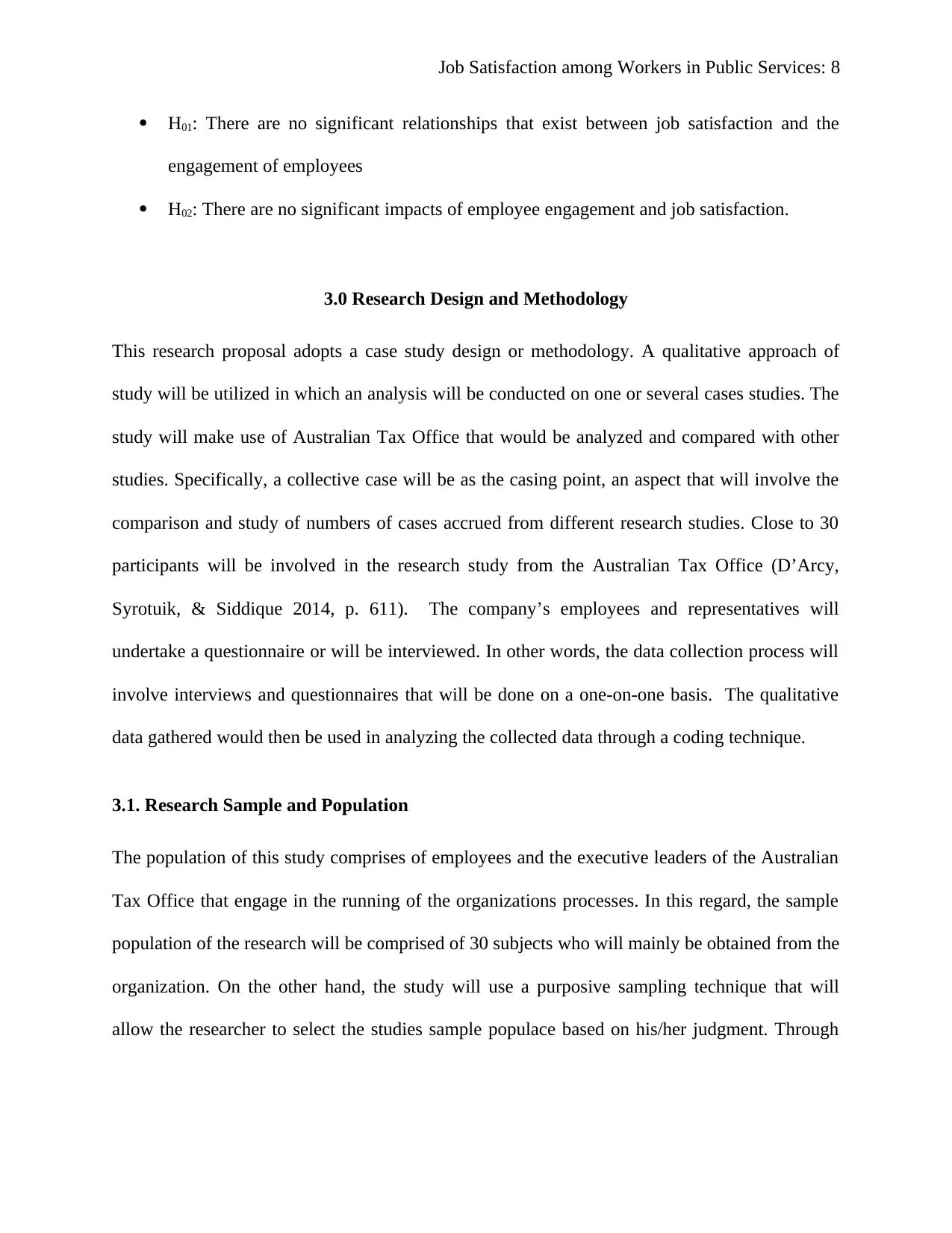
Job Satisfaction among Workers in Public Services: 8
H01: There are no significant relationships that exist between job satisfaction and the
engagement of employees
H02: There are no significant impacts of employee engagement and job satisfaction.
3.0 Research Design and Methodology
This research proposal adopts a case study design or methodology. A qualitative approach of
study will be utilized in which an analysis will be conducted on one or several cases studies. The
study will make use of Australian Tax Office that would be analyzed and compared with other
studies. Specifically, a collective case will be as the casing point, an aspect that will involve the
comparison and study of numbers of cases accrued from different research studies. Close to 30
participants will be involved in the research study from the Australian Tax Office (D’Arcy,
Syrotuik, & Siddique 2014, p. 611). The company’s employees and representatives will
undertake a questionnaire or will be interviewed. In other words, the data collection process will
involve interviews and questionnaires that will be done on a one-on-one basis. The qualitative
data gathered would then be used in analyzing the collected data through a coding technique.
3.1. Research Sample and Population
The population of this study comprises of employees and the executive leaders of the Australian
Tax Office that engage in the running of the organizations processes. In this regard, the sample
population of the research will be comprised of 30 subjects who will mainly be obtained from the
organization. On the other hand, the study will use a purposive sampling technique that will
allow the researcher to select the studies sample populace based on his/her judgment. Through
H01: There are no significant relationships that exist between job satisfaction and the
engagement of employees
H02: There are no significant impacts of employee engagement and job satisfaction.
3.0 Research Design and Methodology
This research proposal adopts a case study design or methodology. A qualitative approach of
study will be utilized in which an analysis will be conducted on one or several cases studies. The
study will make use of Australian Tax Office that would be analyzed and compared with other
studies. Specifically, a collective case will be as the casing point, an aspect that will involve the
comparison and study of numbers of cases accrued from different research studies. Close to 30
participants will be involved in the research study from the Australian Tax Office (D’Arcy,
Syrotuik, & Siddique 2014, p. 611). The company’s employees and representatives will
undertake a questionnaire or will be interviewed. In other words, the data collection process will
involve interviews and questionnaires that will be done on a one-on-one basis. The qualitative
data gathered would then be used in analyzing the collected data through a coding technique.
3.1. Research Sample and Population
The population of this study comprises of employees and the executive leaders of the Australian
Tax Office that engage in the running of the organizations processes. In this regard, the sample
population of the research will be comprised of 30 subjects who will mainly be obtained from the
organization. On the other hand, the study will use a purposive sampling technique that will
allow the researcher to select the studies sample populace based on his/her judgment. Through
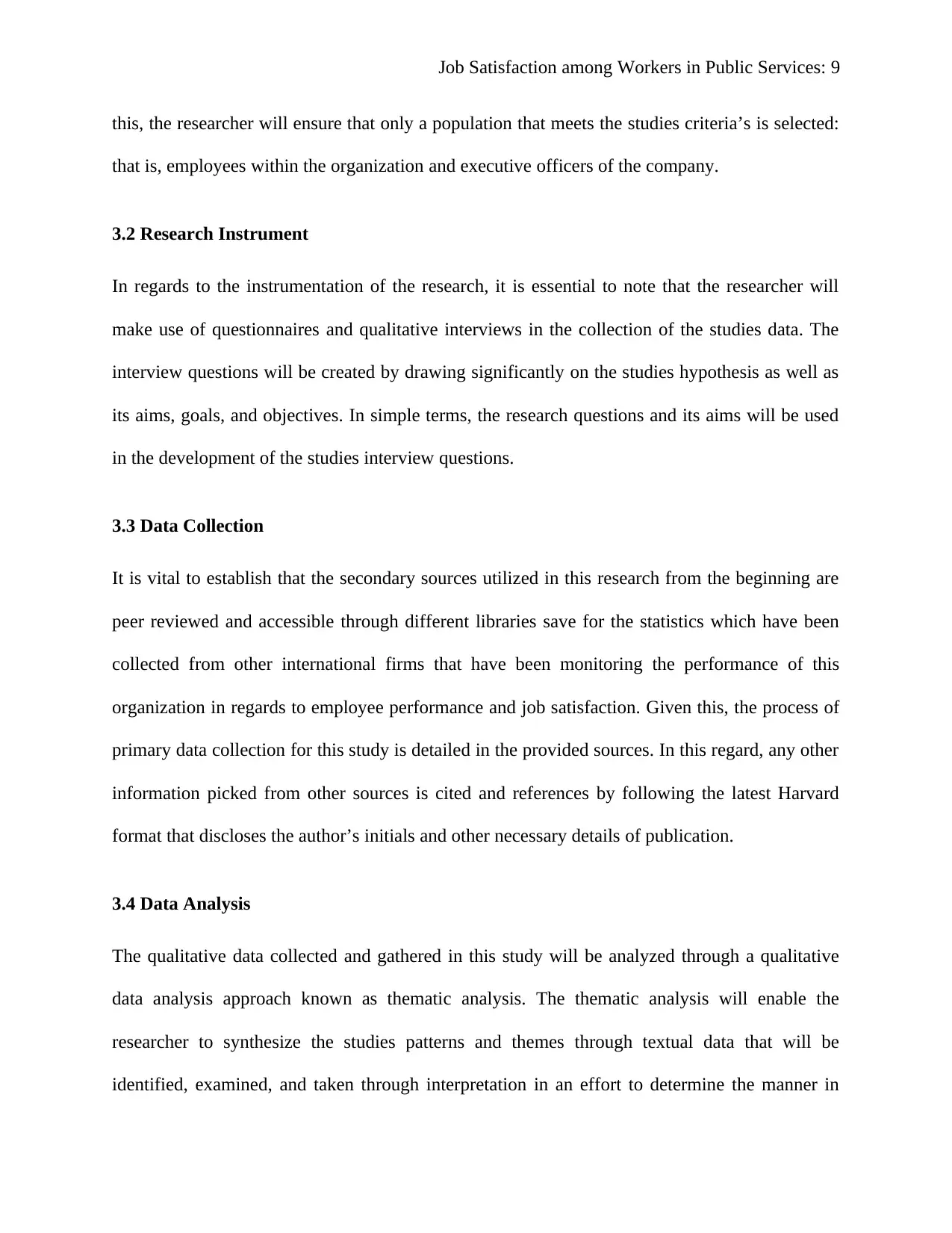
Job Satisfaction among Workers in Public Services: 9
this, the researcher will ensure that only a population that meets the studies criteria’s is selected:
that is, employees within the organization and executive officers of the company.
3.2 Research Instrument
In regards to the instrumentation of the research, it is essential to note that the researcher will
make use of questionnaires and qualitative interviews in the collection of the studies data. The
interview questions will be created by drawing significantly on the studies hypothesis as well as
its aims, goals, and objectives. In simple terms, the research questions and its aims will be used
in the development of the studies interview questions.
3.3 Data Collection
It is vital to establish that the secondary sources utilized in this research from the beginning are
peer reviewed and accessible through different libraries save for the statistics which have been
collected from other international firms that have been monitoring the performance of this
organization in regards to employee performance and job satisfaction. Given this, the process of
primary data collection for this study is detailed in the provided sources. In this regard, any other
information picked from other sources is cited and references by following the latest Harvard
format that discloses the author’s initials and other necessary details of publication.
3.4 Data Analysis
The qualitative data collected and gathered in this study will be analyzed through a qualitative
data analysis approach known as thematic analysis. The thematic analysis will enable the
researcher to synthesize the studies patterns and themes through textual data that will be
identified, examined, and taken through interpretation in an effort to determine the manner in
this, the researcher will ensure that only a population that meets the studies criteria’s is selected:
that is, employees within the organization and executive officers of the company.
3.2 Research Instrument
In regards to the instrumentation of the research, it is essential to note that the researcher will
make use of questionnaires and qualitative interviews in the collection of the studies data. The
interview questions will be created by drawing significantly on the studies hypothesis as well as
its aims, goals, and objectives. In simple terms, the research questions and its aims will be used
in the development of the studies interview questions.
3.3 Data Collection
It is vital to establish that the secondary sources utilized in this research from the beginning are
peer reviewed and accessible through different libraries save for the statistics which have been
collected from other international firms that have been monitoring the performance of this
organization in regards to employee performance and job satisfaction. Given this, the process of
primary data collection for this study is detailed in the provided sources. In this regard, any other
information picked from other sources is cited and references by following the latest Harvard
format that discloses the author’s initials and other necessary details of publication.
3.4 Data Analysis
The qualitative data collected and gathered in this study will be analyzed through a qualitative
data analysis approach known as thematic analysis. The thematic analysis will enable the
researcher to synthesize the studies patterns and themes through textual data that will be
identified, examined, and taken through interpretation in an effort to determine the manner in
⊘ This is a preview!⊘
Do you want full access?
Subscribe today to unlock all pages.

Trusted by 1+ million students worldwide
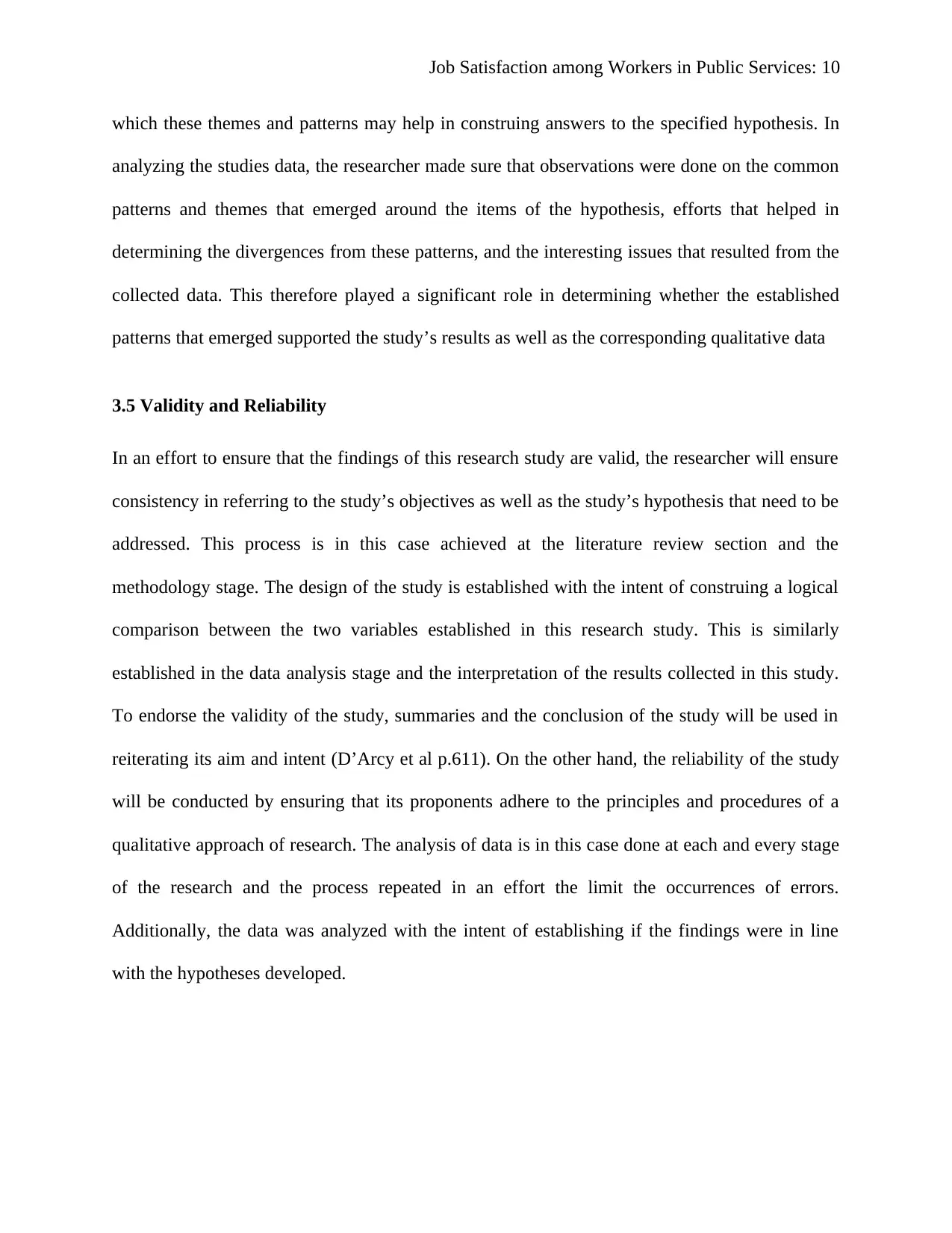
Job Satisfaction among Workers in Public Services: 10
which these themes and patterns may help in construing answers to the specified hypothesis. In
analyzing the studies data, the researcher made sure that observations were done on the common
patterns and themes that emerged around the items of the hypothesis, efforts that helped in
determining the divergences from these patterns, and the interesting issues that resulted from the
collected data. This therefore played a significant role in determining whether the established
patterns that emerged supported the study’s results as well as the corresponding qualitative data
3.5 Validity and Reliability
In an effort to ensure that the findings of this research study are valid, the researcher will ensure
consistency in referring to the study’s objectives as well as the study’s hypothesis that need to be
addressed. This process is in this case achieved at the literature review section and the
methodology stage. The design of the study is established with the intent of construing a logical
comparison between the two variables established in this research study. This is similarly
established in the data analysis stage and the interpretation of the results collected in this study.
To endorse the validity of the study, summaries and the conclusion of the study will be used in
reiterating its aim and intent (D’Arcy et al p.611). On the other hand, the reliability of the study
will be conducted by ensuring that its proponents adhere to the principles and procedures of a
qualitative approach of research. The analysis of data is in this case done at each and every stage
of the research and the process repeated in an effort the limit the occurrences of errors.
Additionally, the data was analyzed with the intent of establishing if the findings were in line
with the hypotheses developed.
which these themes and patterns may help in construing answers to the specified hypothesis. In
analyzing the studies data, the researcher made sure that observations were done on the common
patterns and themes that emerged around the items of the hypothesis, efforts that helped in
determining the divergences from these patterns, and the interesting issues that resulted from the
collected data. This therefore played a significant role in determining whether the established
patterns that emerged supported the study’s results as well as the corresponding qualitative data
3.5 Validity and Reliability
In an effort to ensure that the findings of this research study are valid, the researcher will ensure
consistency in referring to the study’s objectives as well as the study’s hypothesis that need to be
addressed. This process is in this case achieved at the literature review section and the
methodology stage. The design of the study is established with the intent of construing a logical
comparison between the two variables established in this research study. This is similarly
established in the data analysis stage and the interpretation of the results collected in this study.
To endorse the validity of the study, summaries and the conclusion of the study will be used in
reiterating its aim and intent (D’Arcy et al p.611). On the other hand, the reliability of the study
will be conducted by ensuring that its proponents adhere to the principles and procedures of a
qualitative approach of research. The analysis of data is in this case done at each and every stage
of the research and the process repeated in an effort the limit the occurrences of errors.
Additionally, the data was analyzed with the intent of establishing if the findings were in line
with the hypotheses developed.
Paraphrase This Document
Need a fresh take? Get an instant paraphrase of this document with our AI Paraphraser
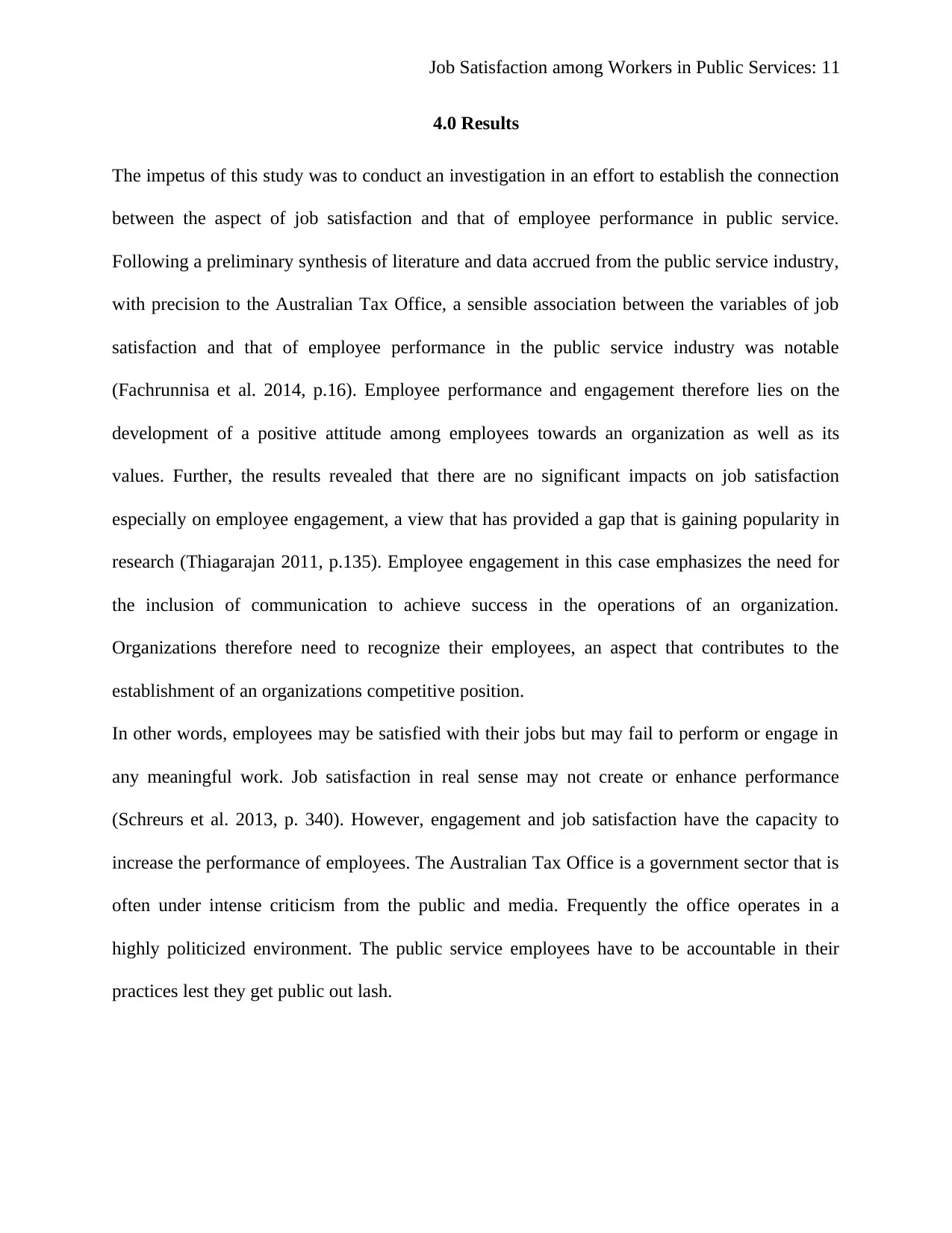
Job Satisfaction among Workers in Public Services: 11
4.0 Results
The impetus of this study was to conduct an investigation in an effort to establish the connection
between the aspect of job satisfaction and that of employee performance in public service.
Following a preliminary synthesis of literature and data accrued from the public service industry,
with precision to the Australian Tax Office, a sensible association between the variables of job
satisfaction and that of employee performance in the public service industry was notable
(Fachrunnisa et al. 2014, p.16). Employee performance and engagement therefore lies on the
development of a positive attitude among employees towards an organization as well as its
values. Further, the results revealed that there are no significant impacts on job satisfaction
especially on employee engagement, a view that has provided a gap that is gaining popularity in
research (Thiagarajan 2011, p.135). Employee engagement in this case emphasizes the need for
the inclusion of communication to achieve success in the operations of an organization.
Organizations therefore need to recognize their employees, an aspect that contributes to the
establishment of an organizations competitive position.
In other words, employees may be satisfied with their jobs but may fail to perform or engage in
any meaningful work. Job satisfaction in real sense may not create or enhance performance
(Schreurs et al. 2013, p. 340). However, engagement and job satisfaction have the capacity to
increase the performance of employees. The Australian Tax Office is a government sector that is
often under intense criticism from the public and media. Frequently the office operates in a
highly politicized environment. The public service employees have to be accountable in their
practices lest they get public out lash.
4.0 Results
The impetus of this study was to conduct an investigation in an effort to establish the connection
between the aspect of job satisfaction and that of employee performance in public service.
Following a preliminary synthesis of literature and data accrued from the public service industry,
with precision to the Australian Tax Office, a sensible association between the variables of job
satisfaction and that of employee performance in the public service industry was notable
(Fachrunnisa et al. 2014, p.16). Employee performance and engagement therefore lies on the
development of a positive attitude among employees towards an organization as well as its
values. Further, the results revealed that there are no significant impacts on job satisfaction
especially on employee engagement, a view that has provided a gap that is gaining popularity in
research (Thiagarajan 2011, p.135). Employee engagement in this case emphasizes the need for
the inclusion of communication to achieve success in the operations of an organization.
Organizations therefore need to recognize their employees, an aspect that contributes to the
establishment of an organizations competitive position.
In other words, employees may be satisfied with their jobs but may fail to perform or engage in
any meaningful work. Job satisfaction in real sense may not create or enhance performance
(Schreurs et al. 2013, p. 340). However, engagement and job satisfaction have the capacity to
increase the performance of employees. The Australian Tax Office is a government sector that is
often under intense criticism from the public and media. Frequently the office operates in a
highly politicized environment. The public service employees have to be accountable in their
practices lest they get public out lash.
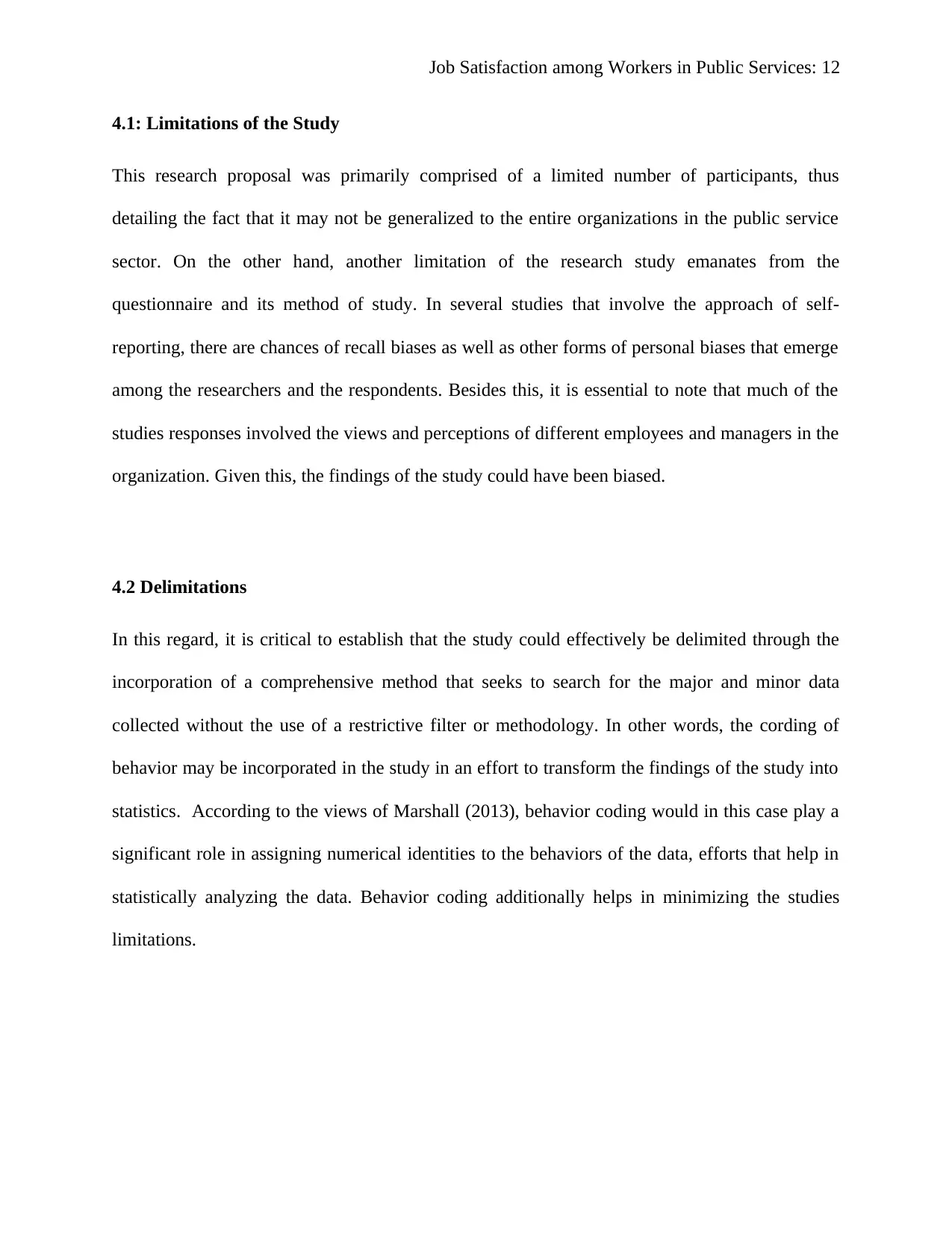
Job Satisfaction among Workers in Public Services: 12
4.1: Limitations of the Study
This research proposal was primarily comprised of a limited number of participants, thus
detailing the fact that it may not be generalized to the entire organizations in the public service
sector. On the other hand, another limitation of the research study emanates from the
questionnaire and its method of study. In several studies that involve the approach of self-
reporting, there are chances of recall biases as well as other forms of personal biases that emerge
among the researchers and the respondents. Besides this, it is essential to note that much of the
studies responses involved the views and perceptions of different employees and managers in the
organization. Given this, the findings of the study could have been biased.
4.2 Delimitations
In this regard, it is critical to establish that the study could effectively be delimited through the
incorporation of a comprehensive method that seeks to search for the major and minor data
collected without the use of a restrictive filter or methodology. In other words, the cording of
behavior may be incorporated in the study in an effort to transform the findings of the study into
statistics. According to the views of Marshall (2013), behavior coding would in this case play a
significant role in assigning numerical identities to the behaviors of the data, efforts that help in
statistically analyzing the data. Behavior coding additionally helps in minimizing the studies
limitations.
4.1: Limitations of the Study
This research proposal was primarily comprised of a limited number of participants, thus
detailing the fact that it may not be generalized to the entire organizations in the public service
sector. On the other hand, another limitation of the research study emanates from the
questionnaire and its method of study. In several studies that involve the approach of self-
reporting, there are chances of recall biases as well as other forms of personal biases that emerge
among the researchers and the respondents. Besides this, it is essential to note that much of the
studies responses involved the views and perceptions of different employees and managers in the
organization. Given this, the findings of the study could have been biased.
4.2 Delimitations
In this regard, it is critical to establish that the study could effectively be delimited through the
incorporation of a comprehensive method that seeks to search for the major and minor data
collected without the use of a restrictive filter or methodology. In other words, the cording of
behavior may be incorporated in the study in an effort to transform the findings of the study into
statistics. According to the views of Marshall (2013), behavior coding would in this case play a
significant role in assigning numerical identities to the behaviors of the data, efforts that help in
statistically analyzing the data. Behavior coding additionally helps in minimizing the studies
limitations.
⊘ This is a preview!⊘
Do you want full access?
Subscribe today to unlock all pages.

Trusted by 1+ million students worldwide
1 out of 16
Related Documents
Your All-in-One AI-Powered Toolkit for Academic Success.
+13062052269
info@desklib.com
Available 24*7 on WhatsApp / Email
![[object Object]](/_next/static/media/star-bottom.7253800d.svg)
Unlock your academic potential
Copyright © 2020–2025 A2Z Services. All Rights Reserved. Developed and managed by ZUCOL.




